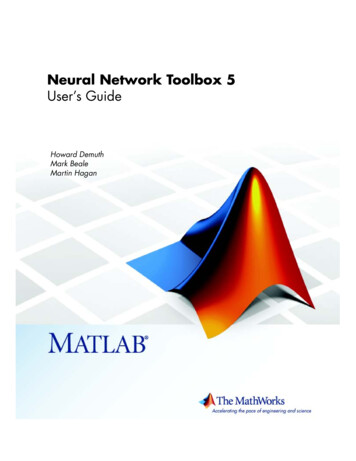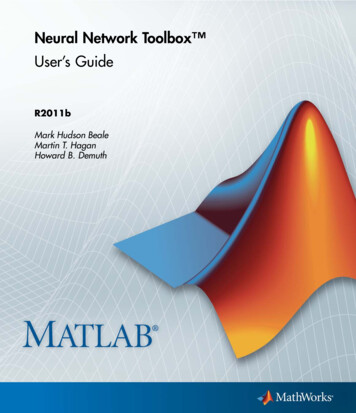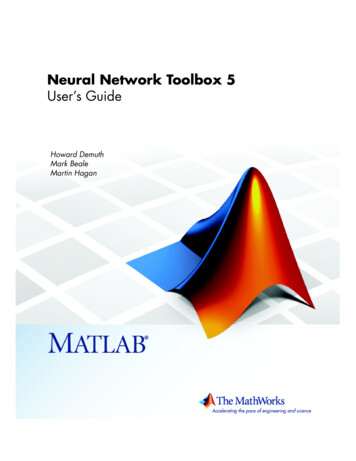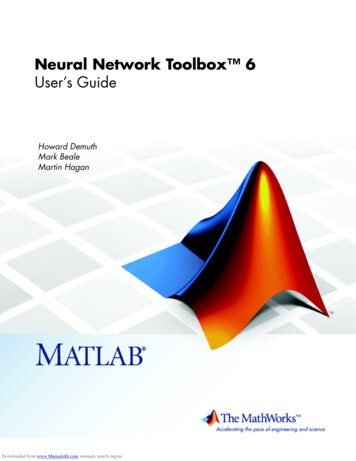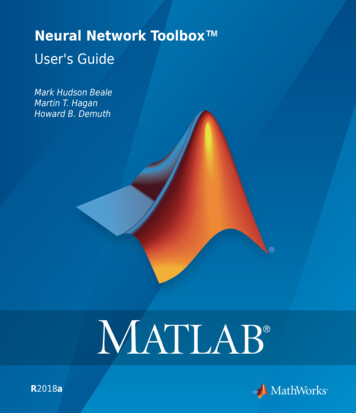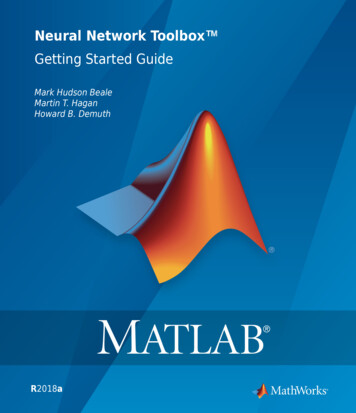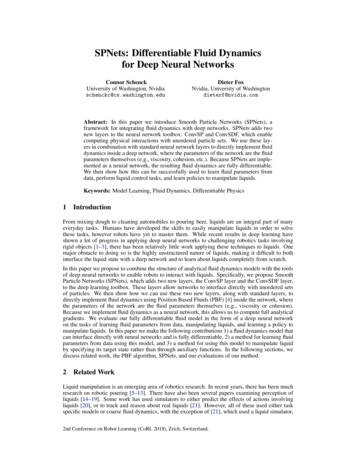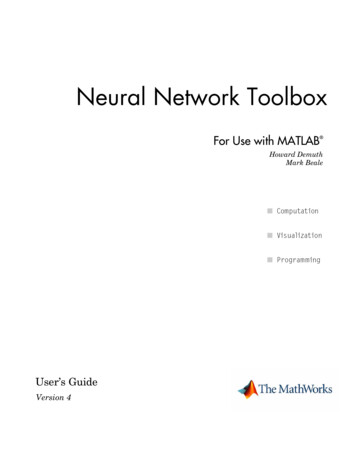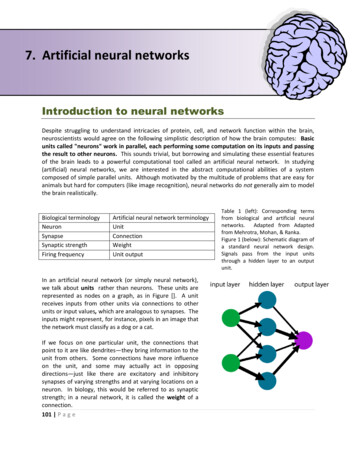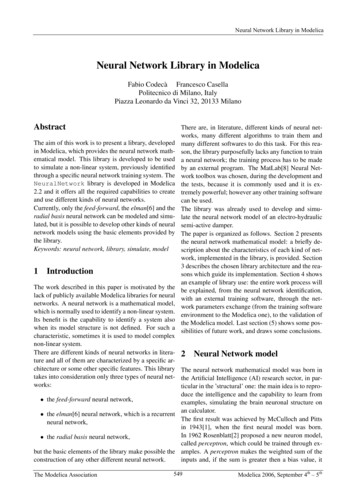
Transcription
Neural Network Library in ModelicaNeural Network Library in ModelicaFabio Codecà Francesco CasellaPolitecnico di Milano, ItalyPiazza Leonardo da Vinci 32, 20133 MilanoAbstractThe aim of this work is to present a library, developedin Modelica, which provides the neural network mathematical model. This library is developed to be usedto simulate a non-linear system, previously identifiedthrough a specific neural network training system. TheNeuralNetwork library is developed in Modelica2.2 and it offers all the required capabilities to createand use different kinds of neural networks.Currently, only the feed-forward, the elman[6] and theradial basis neural network can be modeled and simulated, but it is possible to develop other kinds of neuralnetwork models using the basic elements provided bythe library.Keywords: neural network, library, simulate, model1 IntroductionThere are, in literature, different kinds of neural networks, many different algorithms to train them andmany different softwares to do this task. For this reason, the library purposefully lacks any function to traina neural network; the training process has to be madeby an external program. The MatLab[8] Neural Network toolbox was chosen, during the development andthe tests, because it is commonly used and it is extremely powerful; however any other training softwarecan be used.The library was already used to develop and simulate the neural network model of an electro-hydraulicsemi-active damper.The paper is organized as follows. Section 2 presentsthe neural network mathematical model: a briefly description about the characteristics of each kind of network, implemented in the library, is provided. Section3 describes the chosen library architecture and the reasons which guide its implementation. Section 4 showsan example of library use: the entire work process willbe explained, from the neural network identification,with an external training software, through the network parameters exchange (from the training softwareenvironment to the Modelica one), to the validation ofthe Modelica model. Last section (5) shows some possibilities of future work, and draws some conclusions.The work described in this paper is motivated by thelack of publicly available Modelica libraries for neuralnetworks. A neural network is a mathematical model,which is normally used to identify a non-linear system.Its benefit is the capability to identify a system alsowhen its model structure is not defined. For such acharacteristic, sometimes it is used to model complexnon-linear system.There are different kinds of neural networks in litera- 2 Neural Network modelture and all of them are characterized by a specific architecture or some other specific features. This library The neural network mathematical model was born intakes into consideration only three types of neural net- the Artificial Intelligence (AI) research sector, in parworks:ticular in the ’structural’ one: the main idea is to reproduce the intelligence and the capability to learn from the feed-forward neural network,examples, simulating the brain neuronal structure onan calculator. the elman[6] neural network, which is a recurrentThe first result was achieved by McCulloch and Pittsneural network,in 1943[1], when the first neural model was born.In 1962 Rosenblatt[2] proposed a new neuron model, the radial basis neural network,called perceptron, which could be trained through exbut the basic elements of the library make possible the amples. A perceptron makes the weighted sum of theconstruction of any other different neural network.inputs and, if the sum is greater then a bias value, itThe Modelica Association549Modelica 2006, September 4th – 5th
F. Codecà, F. Casellasets its output as ’1’. The training is the process used totune the value of the bias and of the parameters whichweight the inputs.Some studies[3] underline the perceptron training limits. Next studies[4], otherwise, show that different basic neuron models, complex neuron networks architecture as suitable learning algorithms, ensure to gobeyond the theoretical perceptron limits.Three kinds of neural networks, which are describedin the following paragraphs, were taken into consideration in the library: they differ in neuron model andnetwork architecture.2.1Feed-forward neural networkThe feed-forward neural network is the most used neural network architecture: it is based on the series connection of neuron layers, each one composed by a setof neurons connected in parallel. Examine the i thlayer: the layer inputs, u1 , u2 , . . . , un , are used by rneurons, which produce r output signals, y1 , y2 , . . . , yr .These signals are the inputs of the next layer, thei 1 th layer.s lim σ( ) σin f ,s s lim σ( ) σin f .s For this reasons, it is usually called sigmoid. Differentfunctions can be used; the most used are: σ(s) tanh(s) (called in MatLab tangsig); σ(s) 11 exp n(called in MatLab logsig);A linear function is also used as activation function: itis normally used for the neurons which compose theoutput layer (σ(s) s (called in MatLab purelin)).The feed-forward architecture allows to build verycomplex neural networks: the only constraint is toconnect the layer in series and the neurons of a layer inparallel, each of them with the same activation function. The first section of the network, which takes theinputs and passes them to the first layer without doinganything, is usually called Input layer. The last layeris called Output layer and the others are called Hiddenlayer1 .Figure 1: Standard neuron modelThe neuron used in the feed-forward neural networkis called standard neuron (figure 1). A standard neuron maps Rq into R; it is characterized by n inputs,u1 , u2 , . . . , un , and one output, y. The first step, whichis taken by the neuron, is to compute a weighted sumof the inputs: the result is called activation signalFigure 2: A feed-forward neural network structureAn important theoretical result, related to the feedforward neural network, ensures to specify which isthe non-linear function class that can be evaluated by aspecific neural network. The result is applicable to different kinds of networks: in particular, it involves thes w0 u0 w1 u1 w2 u2 . . . wn un ,standard neural network. This network is composedby only two layers: an Hidden layer, composed by mwhere w0 , w1 , w2 , . . . , wn are real parameters. w0 is the neurons2 , which processes n inputs, u1 , u2 , . . . , un , andneuron bias and w1 , w2 , . . . , wn are the neuron weights. an Output layer, composed by one neuron with a linearThe second step is to perform a non-linear elaboration activation function.of s, obtaining y. This is computed using a function1 this is not an univocal nomenclature; for example, in MatLab,σ( ) (R R), called activation function; it is usually the first neuron layer is called Input layer and the others are simplya real function of real variable, monotonically increas- called layer.2 all having the same activation functionsing, with a lower and an upper asymptote:The Modelica Association550Modelica 2006, September 4th – 5th
Neural Network Library in ModelicaTheorem 1 (Universal Approximator[4]) Takeastandard neural network where σ( ) satisfies thefollowing conditions:1. lims σ(s) 1,2. lims σ(s) 0,3. σ( ) is continuous.Taking a function g(u) : Rq R, continuous on a setIu compact in Rq , and an ε 0, a standard neuralnetwork exists which achieves the transformation y f (u) so thatFigure 3: An Elman neural network2.3Radial basis neural network g(u) f (u) ε, u Iu .The Radial basis neural network is used as an alternative to the feed-forward neural network. Like this one,it is based on the series connection of layers, each of2.2 Recurrent neural network (Elman)them composed by a set of neurons connected in parA particular type of neural network is the recurrentallel. Two are the main differences:neural network. This network is a dynamical system,in which the output depends on the inputs and the in the number of layers is commonly fixed, with oneternal state, which evolves with the network inputs. IfHidden layer and one Output layer;the internal state is Z(t), the network then agrees to the the basic neuron is not the standard neuron but itfollowing relations:is called radial neuron. Z(t 1) F(Z(t),U(t))A radial neuron maps Rq into R; it is characterized byY (t) G(Z(t),U(t))n inputs, u1 , u2 , . . . , un , and one output, y. The first stepRecurrent networks are usually based on a feedback took by the radial neuron is to compute an activationloop in the network architecture, but this is not the only signal: it differs from the standard one because it isway.not a weighted sum of inputs but it is equal to:In the library, the Elman[6] neural network is consids dist({u1 , u2 , . . . , un } , {α1 , α2 , . . . , αn })b,,ered: in this network, the feedback loop is between theoutput of the Hidden layer and the input of the layeritself. This allows the network to learn, recognize andcreate temporal and spatial models.An Elman neural network is usually composed by twolayer connected as shown in figure 3: there is an Hidden layer, which is the recurrent layer, composed byneurons with an hyperbolic tangent activation function(σ( ) tanh( )), and an output layer, characterizedby a linear activation function.As for the feed-forward neural network, the universalapproximator theorem ensures that the Elman neuralnetwork is an universal approximator of a non-linearfunction. The only requirement is that the more thefunction to be estimated becomes complex, the morethe number of the neurons, which compose the Hiddenlayer, increases.The only difference between a feed-forward neuralnetwork and an Elman neural network is the recurrence: this allows the network to learn spatial and temporal models.The Modelica Associationwhere α1 , α2 , . . . , αn are real parameters, regardingwhich distances of the inputs are calculated (they arecalled centers of the neuron), b is called neuron amplitude and the function dist({x1 , x2 } , {a1 , a2 }) computesthe euclidean distance between {x1 , x2 } and {a1 , a2 }3 .The following step is to perform a non-linear elaboration of s, obtaining y. This is made using the function2σ( ) exp ( ) (R R) which is the radial neuronactivation function; it is not a sigmoid function but abell-shaped function (figure 4).As previously remarked, the radial basis neural network architecture is commonly fixed: there is an Hidden layer, composed by radial neurons, and one Output layer, composed by a standard neuron with a linearactivation function (purelin). Although the structure ofthis neural network is more limited, compared to thefeed-forward one, this is not a limit for its approximator capability.5513 dist({x1 , x2 } , {a1 , a2 }) p(x1 a1 )2 (x2 a2 )2Modelica 2006, September 4th – 5th
F. Codecà, F. Casella weightTable:it is a matrix which collects the weight parameters (or the centersof neurons) used by every neuron of thelayer to weight the inputs; its dimension is[numNeurons numInputs]; biasTable: it is a vector which collects the biasesof neurons that compose the layer; its dimensionis [numNeurons 1];Figure 4: Radial neuron activation functionAs for the feed-forward and the Elman neural net NeuronActivationFunction: it is the activationworks, the universal approximator theorem ensuresfunction used to compute the output by each neuthat this kind of neural network is an universal approxron of the layer. The neurons, which compose aimator of a non-linear function. The only requirementlayer, can only have the same activation function.is that, the more the function to approximate becomescomplex, the more the number of the neurons which Using a network layer as the basic element has the onlycompose the Hidden layer increases.limit that the activation function of each neuron in alayer must to be the same, but the neural network architectures previously presented don’t need this prop3 NeuralNetwork libraryerty. Moreover this choice ensures to have an easierdata exchange between the neural network training enThe reason of this library is the lack of an suitable vironment and the Modelica one.Modelica library, able to simulate a neural network.This is particularly true when the MatLab Neural NetThe aim was to develop a library with the capabilitieswork toolbox is used to train a neural network. Asto create and to simulate such a mathematical model.reported in the section 4, in the object used by MatLabThere are already many different algorithms to trainto store a neural network, the weights (or the centers ofa neural network and many different softwares to doneuron) and the bias of layer are collected in a matrixthis task so no training algorithm was given. This rewith the same property of the matrix used to initializequires that the training process must be performed bya NeuralNetworkLayer.an external software. The MatLab[8] Neural NetworkThe library is organized in a tree-based fashion (Figuretoolbox was chosen, during the development and the5), and it is composed by five sub-packages:tests, because it is used commonly and it is extremelypowerful; however any other training software can be the package BaseClasses: it contains onlyused. These elements affect some library architecturalone element, the NeuralNetworkLayer;choices.The first aim was to give to the users all the elements the package Networks: it contains some neuto create the previously presented neural networks: noral networks based on the connection of manyconstraints were put in for the user, who can create anyNeuralNetworkLayer;kind of network architecture without limits. The userhimself is directly responsible to use the basic blocks the package Utilities: it contains differentcorrectly and no checks are performed by the libraryfunctions and models used to define some libraryblocks.elements or used itself in the library;The basic element of the NeuralNetwork library waschosen to be a network layer. A layer in a neural net the package Types: it contains the constantswork (NeuralNetworkLayer) is a set of neuronsused to specify the activation functions whichwhich are connected in parallel[5]. It is characterizedcharacterize a NeuralNetworkLayer;by the following parameters: numNeurons: it is the number of neurons whichcompose the layer; the package Examples: it contains some examples which allow the user to explore the librarycapabilities. numInputs: it is the number of inputs of the layer;The Modelica Association552Modelica 2006, September 4th – 5th
Neural Network Library in Modelica TanSig: the block acts as a layer composed bystandard non linear neurons; the output is equalto the hyperbolic tangent of the activation sign aly Modelica.Math.tanh(s); LogSig: the block acts as a layer composed bystandard non linear neurons; the output is equalto the value returned by the LogSig function:y NeuralNetwork.Utilities.LogSig(s); RadBas: the block acts as a layer composed byradial non linear neurons; the output is computedwith the following steps:Figure 5: Library structure3.1– the euclidean distance between thecenters of layer neurons and the inputs is evaluated using the functionBaseClasses - NeuralNetworkLayerAs previously described, there is only one element in the BaseClasses package, theNeuralNetworkLayer. This is a block witha MIMO interface, in which the number of inputs isspecified through a parameter and the outputs numberis the same to the neurons one.The parameters of the NeuralNetworkLayer are: numNeurons: it is the number of neurons whichcompose the layer numInputs: it is the number of inputs to the layer weightTable: it is the table of the weights, if thelayer is composed by standard neurons, or the table of the centers of the neuron, if the layer is 3.2composed by radial neuronsNeuralNetwork.Utilities.Dist()with the following parameters:Table, matrix(u)weight-– the element-wise product betweenthe previous function output and thebias matrix is calculated using theNeuralNetwork.Utilities.ElementWiseProduct function: this value isthe activation signal s– the output is then evaluated using thespecific radial neuron activation function(NeuralNetwork.Utilities.RadBas);Networks biasTable: it is the bias matrix of the neuronswhich compose the layer NeuronActivationFunction: it is the activationfunction of the layer neuronsThe NeuronActivationFunction characterizes thebehavior of the neuron network layer. The paFigure 6: Networks package structurerameter can be selected in the set, defined byNeuralNetwork.Types.ActivationFuncThis package (shown in figure 6) is composed bytion; the possible choices and behaviors are:five blocks: each one represents a neural network. PureLin: the block acts as a layer composed by The feed-forward neural network and the radial bastandard linear neurons; the output is equal to the sis neural network are easily composed using theactivation signal s, which is equal toNeuralNetworkLayer block.The case of the Elman neural network (figure 7 showsy s weightTable * u biasTable[:,1]the model in Dymola[7]), which in the library is calledThe Modelica Association553Modelica 2006, September 4th – 5th
F. Codecà, F. CasellaNeuralNetwork RecurrentOne(Two)Layer4 ,is different. In figure 7 the NeuralNetwork RecurrentOneLayer is shown: the delay block hasbeen introduced to create the recurrence. The parameters of every layer and the parameter of the delayblock, which is the samplePeriod of the recurrentlayer, can be tuned. The samplePeriod has to be equalto the input signal sample rate, so that the network canwork correctly.and RadBas) or to elaborate signals which are usedby neurons to compute the activation signal (Distand ElementWiseProduct are used by a layercomposed by radial).4An application exampleThe package Examples contains some instanceswhich allow the user to explore the library capabilities. In this section, an example of how to use theNeuralNetwork library is shown: the entire workprocess will be explained, from the neural networkidentification, with MatLab Neural Network toolbox,through the network parameters exchange, to the validation on the model implementation in Modelica.Figure 7: Elman neural network in DymolaThe NeuralNetwork.Utilities.UnitDelayMIMO was introduced to realize the layer feedback: it behaves as the Modelica.Blocks.Discrete.UnitDelay but it has a MIMO interfacein place of the SISO one.3.3UtilitiesFigure 9: NARX: neural network with external dynamicsThe example shown here (which is the modelFeedForwardNeuralNetworkplacedinExamples package) is about a feed-forwardnetwork with external dynamics. This neural network,shown in figure 9, is a feed-forward neural networkFigure 8: Utilities packagein which the signals used as inputs are previouslydelayed. The feed-forward neural network withThe Utilities package (shown in fi- external dynamic, which is normally called NARX,gure 8) is composed by some mathemati- performs the following functioncal functions and blocks needed to the liy(t) f (u(t) . . . u(t na ), y(t) . . . y(t nb )).brary to work.In the blocks there are theNeuralNetwork.Utilities.UnitDelayThis example shows how to use the elements of theMIMO block, used to model an Elman neural network, NeuralNetwork library to create a feed-forwardand the NeuralNetwork.Utilities.Sam- neural network with external dynamic, where u is aplerMIMO, used to sample more signals at the same vector composed by two elements, na 2 and nb 0.time and used to build the Elman neural network First of all we have to create the model of the processexample. The mathematical functions instead are which has to be identified by the network. We assumeused to model a specific activation function (LogSig that the process is driven by the non-linear function4 theyF(t) (3x(t)x(t 1)x(t 2)) (y(t)y(t 2)),differ for the number of recurrent layerThe Modelica Association554Modelica 2006, September 4th – 5th
Neural Network Library in Modelicawhere x and y are the inputs of the system. Note thatthe process is dynamic because F(t) uses the input values at t time, t 1 time and t 2. For this reason wechoose to use a dynamical feed-forward network with6 inputs:net.trainParam.epochs 100;[net,tr] train(net,[in X;in Y],f);To see how the network has learned the non-linear system the command sim can be usedf SIM sim(net,[in X;in Y]);y(t) f (x(t), y(t), x(t 1), y(t 1), x(t 2), y(t 2)).To train the network is mandatory to have some inputsignals and the correspondent outputs. The Matlab environment can be used: define the input signals withthe following commands5t 0:0.01:10;x sin(2*pi*t);y cos(5*pi*t);and calculate the output signal of the process from theinputs previously defined.for k 3:length(t)f(k) (3*x(k)*x(k-1)*x(k-2));f(k) f(k) (y(k)*y(k-2));endAfter the input and output signals are created, the network has to be built. To construct a feed-forward neural network, the command newff has to be used. Asparameters, the command requires the variances of theinputs, the dimension of the network and the layer activation functions. To do this use the following commandsvarvarvarvarnetxXyY Figure 10: Real process and neural network outputcomparisonPlotting the real output and the network simulated output (figure 10), we can see that the network has identified the non-linear system very well. Two ways weretaken into consideration in order to use the parameterscoming from the MatLab environment: [min(x) max(x)]; [var x;var x;var x]; [min(y) max(y)]; [var y;var y;var y];newff([var X ; var Y],[4 1],{’tansig’,’purelin’}); create a specific script for MatLab (called extractData.m) which collects the parameters from theenvironment and creates a text file containing allthe information as the Modelica notation and thelibrary requests;Note that var X and var Y are a 3 2 matrix, with use the DataFiles library which providesone line for x(t), one for x(t 1) and one for x(t 2).some functions to read/write parametersTo train the network, the input signal matrices have tofrom/into .mat files (saved using the -V4 option).be created (they are in X and in Y). Some parameters, like the train method and the train epochs num- The DataFiles library is a particular implementaber, has to be set and then the function train can be tion supplied by Dymola to manage .mat files: this apused. This is done with the following commands:proach was used in absence of a general solution inin X [ x ; [0 x(1:end-1)] ;Modelica.[0 0 x(1:end-2)] ];In this particular example the first way was used. Atin Y [ y ; [0 y(1:end-1)] ;first, it has to be understood how the MatLab saves[0 0 y(1:end-2)] ];the feed-forward neural network parameters. Watchnet.trainFcn ’trainlm’;ing the figure 11, which shows how MatLab maps theweights and bias of the layer on the network object ma5 when dealing with dynamic feed-forward networks it is verytrices and keeping in mind that the first hidden layer isimportant that the sampling time during the simulation be the sameas the one used for the network training, otherwise the model will called InputLayer and the others only Layer, can benot behave correctly.asserted that:The Modelica Association555Modelica 2006, September 4th – 5th
F. Codecà, F. CasellaFigure 11: MatLab weights and bias matricesFigure 12: FeedForwardNeuralNetwork exam to access to the weights matrix of a layer has to be pleused the command net.X{1,1}6 , where X IWfor the first layer and X LW for the others; theweights matrix is a [S R] , where S is the neuron IN x [t’ , x’];IN y [t’ , y’];number and R the layer inputs numberOUT f [t’ , f SIM’]; to access to the bias matrix has to be used the save testData FeedForwardNN.mat -V4command net.b{1}, [S 1].IN x IN y OUT fUsing this information and the extractData.m script, the figure 13 shows the output of the Modelica simutwo files, which contain the Modelica definition of the lation and the output of MatLab: see that there is nonetwork layers that compose the neural network, were difference between ��tan’)where ’LW.txt’ and ’IW.txt’ are the names ofthe file where the definition of the ModelicaneuralNetwork TwoLayer OutputLayer andHiddenLayer are stored. The other parameters of thecommand are the weights and the bias matrices andthe layer activation function.Now it’s possible to create this neural networkusing the Modelica language7 .At first take aneuralNetwork TwoLayer block and change itsparameters using the results of the previous steps (located in ’IW.txt’ and ’LW.txt’). Then, since the neuralnetwork expects 6 inputs which have to be externallybuilt, some unit delay blocks (with sample time setsto 0.01, which is the input signals sample time) and amultiplexer must be used.As last step, build a .mat file enclosing the input signals used in MatLab to simulate the neural network.To compare the Modelica output to the MatLab one,enclose the output signals too.6 For the index selection please use the MatLab Neural Networktoolbox help.7 The example model (figure 12) was created in Dymola[7]The Modelica AssociationFigure 13: Matlab and Modelica simulation outputcomparisonSimilar examples have been built for the other kindsof networks in the library. They are available in theExamples package, to check their results against theMatlab implementation.5ConclusionA Modelica library, providing the neural networkmathematical model is presented. This library is developed to be used to simulate a non-linear system,556Modelica 2006, September 4th – 5th
Neural Network Library in Modelicapreviously identified through a specific neural networktraining system. The NeuralNetwork library is developed in Modelica 2.2 and it offers all the requiredcapabilities to create and use different kinds of neuralnetworks.Currently, only the feed-forward, the elman[6] and theradial basis neural network can be modeled and simulated, but it is possible to build different network structures, by using the basic elements provided by the library. In section 4, a library extension example isshown: a dynamical neural network model is createdusing the library blocks. The entire work process isexplained, from the neural network identification, withan external training software, through the network parameters exchange (from the training software environment to the Modelica one), to the validation of theModelica model. This lead us to show that there isno difference between the Modelica simulation outputand the MatLab one.The library is publicly available under the ModelicaLicense from the www.modelica.org website.References[1] McCulloch, W. S. and Pitts, W., A logical calculus of the ideas immanent in nervous activity. Bulletin of Mathematical Biophysics, 5, 115–133, 1943.[2] Rosenblatt, F., The perceptron: A probabilisticmodel for information storage and organizationin the brain, Psychological Reviw, 1958, 65, 386408.[3] Minsky, M.L. and Papert, S., Perceptrons: AnIntroduction to Computational Geometry. Cambridge, MA: MIT Press, 1969.[4] Hornik, K., Stinchcombe, M. and White, H.,Multilayer feedforward neural networks are universal approximators, Neural Networks, vol. 2,no. 5, pp. 359–366, 1989.[5] Bittanti, S., Identificazione dei modelli e sistemiadattativi, Pitagora Editrice, 2002.[6] Elman, J. L., Finding structure in time, CognitiveScience, 15, 1990, 179-211.[7] Dymola, Dynamic Modeling Laboratory, Dynasim AB, Lund, Sweden.[8] The Math Works Inc., MATLAB R - The language of Technical Computing, 1997.The Modelica Association557Modelica 2006, September 4th – 5th
a neural network and many different softwares to do this task so no training algorithm was given. This re-quires that the training process must be performed by an external software. The MatLab[8] Neural Network toolbox was chosen, during the development and t
